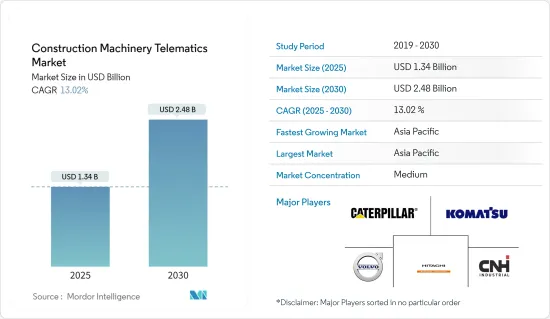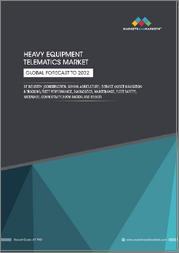
|
시장보고서
상품코드
1687448
건설기계 텔레매틱스 - 시장 점유율 분석, 산업 동향 및 통계, 성장 예측(2025-2030년)Construction Machinery Telematics - Market Share Analysis, Industry Trends & Statistics, Growth Forecasts (2025 - 2030) |
||||||
건설기계 텔레매틱스 시장 규모는 2025년에 13억 4,000만 달러에 이를 것으로 추정됩니다. 예측기간(2025-2030년)의 CAGR은 13.02%를 나타내 2030년에는 24억 8,000만 달러에 달할 것으로 예상됩니다.

건설기계 텔레매틱스 시장은 건설기계 업계 중에서도 역동적으로 진화하고 있는 분야입니다.
건설기계 텔레매틱스 시장은 기계의 효율성에 대한 소비자 수요가 높아짐에 따라 견인되고 있습니다. 하지만 급증하고 있는 것도 건설기계에서의 텔레매틱스의 채용을 뒷받침하고 있습니다.
시장의 성장을 가속하는 주요 요인 중 하나는 인프라, 주택, 비주택 부문에 많은 성장 기회가 있기 때문에 특히 신흥국에서 건설 산업이 성장하고 있다는 것입니다.
건설 활동과 인프라 개발의 급증이 중기 수요를 촉진하고 있습니다.
건설기계 텔레매틱스 시장 동향
굴삭기 부문은 건설기계 텔레매틱스 시장을 독점
굴삭기에서의 텔레매틱스의 도입은 주로 기술의 진보와 전동 모델 시장 도입으로 최근 몇 년 동안 큰 성장을 이루고 있습니다.
예를 들어 2023년 3월, CASE Construction Equipment는 SiteWatch 텔레매틱스를 표준 장비한 CX15EV와 CX25EV의 2대의 전동 미니 굴삭기를 발표했습니다.
그러나 업계가 직면한 주요 과제는 소규모 굴삭기 운반대 운영자들 사이에서 텔레매틱스 기술을 더욱 채택해야 한다는 점입니다. 그리고 그러한 모델을 얻는 것과 관련된 비용으로 인해 현재 텔레매틱스의 주요 사용자는 장비 관리 및 전반적인 비즈니스 효율성을 높이기 위해이 데이터를 활용하는 대규모 굴삭기 함대 운영자입니다.
시장의 많은 기업들은 원격 진단, GPS 추적, 종합적인 함대 관리 등의 기능을 가능하게 하는 고급 텔레매틱스 솔루션과 통합된 굴삭기를 적극적으로 추진하고 있습니다. Cellular 시스템을 표준 장비한 2개의 새로운 6톤 스테이지 V 미니 굴삭기, DX62R-7과 DX63-7을 발표했습니다.
이러한 요인을 고려하면, 굴삭기에서의 텔레매틱스의 이용은 앞으로 수년간 급속한 확대를 계속할 것으로 예상됩니다.
아시아태평양이 계속 높은 시장 점유율을 차지할 전망
이 지역의 건설 산업 성장, 다수의 중장비 가용성, 모바일 장치의 소비자 기반 상승 등이 조사된 시장을 홍보하는 주요 요인 중 일부입니다.
중국은 아시아태평양의 주요국 중 하나이며 경제 성장에 힘입어 건설활동이 활발합니다.
부동산 부문의 불안정한 성장에도 불구하고 중국 정부의 철도 및 도로 인프라의 대폭적인 개발(산업 및 서비스 수요에 대응하기 위해)은 건설 부문의 대폭적인 성장으로 이어졌습니다. 을 지배하고 있기 때문에 공공 지출과 민간 지출 증가는 이 섹터를 세계의 리더적 지위로 밀어 올릴 것으로 예상됩니다.
2022-2023 회계 연도, 인도의 건설기계 부문은 약 15%의 성장률을 기록했습니다. 토목 기계 수요는 도시화, 인프라 정비, 건설 및 광업 부문의 성장 등 다양한 요인에 의해 증가하고 있습니다. Smart City) 등의 노력을 통해 인프라 정비에 힘을 쏟고 있는 것이 육상 운송 기계 수요를 더욱 밀어 올리고 있습니다.
일부 건설 섹터에서는 단기적인 과제가 있는 것, 인도의 중장기적인 성장 스토리는 변하지 않았습니다.
일본 정부 역시 동국이 장래 경험할 것으로 예상되는 주요 장기 프로젝트(자기 부상식 철도의 장기·단기 개발 계획)에 끊임없이 주목하고 있습니다. 공항에의 새로운 철도 링크는 3억엔(200만 달러)을 투자해, 2029년까지 개통할 전망입니다. 따라서, 이러한 긍정적인 성장 동향이 일본의 건설 시장을 밀어 올릴 것으로 예상됩니다.
기타 아시아태평양에는 말레이시아, 인도네시아, 싱가포르, 베트남, 호주, 한국 등의 ASEAN 국가들이 포함되어 있으며, 이들 국가에서는 지속적인 성장이 지속되고 있으며 주택과 상업용 건물 모두에 대한 수요가 지속적으로 증가하고 있습니다.
지역 당국의 이러한 적극적인 노력은 예측 기간 동안 확대될 것으로 예상되며, 따라서 예측 기간 동안 건설기계 텔레매틱스 시장의 성장을 지원하고 있습니다.
건설기계 텔레매틱스 산업 개요
캐터필러, 코마츠, 히타치 건설기계, 현대 건설기계, 볼보 건설기계 등 여러 주요 기업이 시장을 독점하고 있습니다.
2023년 6월 서섹스에 본사를 두고 있는 Southern Cranes사는 Webfleet의 파트너인 AES fleet사와 제휴를 발표했습니다.
2023년 5월 Terex Rough Terrain Cranes는 TerexT-Telematics 솔루션을 갖춘 오프로드 크레인 TRT 65를 발표하여 크레인의 실시간 성능 데이터를 제공했습니다.
기타 혜택
- 엑셀 형식 시장 예측(ME) 시트
- 3개월간의 애널리스트 서포트
목차
제1장 서론
- 조사의 전제조건
- 조사 범위
제2장 조사 방법
제3장 주요 요약
제4장 시장 역학
- 시장 성장 촉진요인
- 건설 및 인프라 활동의 활성화가 수요를 견인
- 커넥티드 테크놀로지가 시장 성장을 가속
- 시장의 과제
- 초기 비용의 높이
- 업계의 매력 - Porter's Five Forces 분석
- 공급기업의 협상력
- 소비자의 협상력
- 신규 참가업체의 위협
- 대체품의 위협
- 경쟁 기업간 경쟁 관계
제5장 시장 세분화
- 기계 유형별
- 크레인
- 굴삭기
- 텔레스코픽 핸들링
- 로더 및 백호
- 기타 기계 유형
- 판매 채널별 유형별
- OEM
- 애프터마켓
- 텔레매틱 기능별
- 추적
- 진단
- 기타 텔레매틱스 기능
- 지역별
- 북미
- 미국
- 캐나다
- 기타 북미
- 유럽
- 독일
- 영국
- 프랑스
- 이탈리아
- 기타 유럽
- 아시아태평양
- 중국
- 인도
- 일본
- 한국
- 기타 아시아태평양
- 세계의 기타 지역
- 남미
- 중동 및 아프리카
- 북미
제6장 경쟁 구도
- 공급업체의 시장 점유율
- 기업 프로파일
- Komatsu Ltd
- Caterpillar Inc.
- Volvo Construction Equipment
- Joseph Cyril Bamford Excavators Ltd(JCB)
- Hitachi Construction Machinery Co. Ltd
- CNH Industrial NV
- Deere & Company
- 현대공장장치
- Liebherr Group
- Doosan Infracore Ltd
- ACTIA Group
- Geotab
- Trimble Inc.
- Orbcomm
- Octo Telematics
제7장 시장 기회와 앞으로의 동향
- 텔레매틱스에 대한 차량 소유자의 기호의 변화
The Construction Machinery Telematics Market size is estimated at USD 1.34 billion in 2025, and is expected to reach USD 2.48 billion by 2030, at a CAGR of 13.02% during the forecast period (2025-2030).

The construction machinery telematics market is a dynamic and evolving sector within the construction machinery industry. Factors such as rapid urbanization, industrialization, rising government investments in infrastructure development, and expansion and growth activities of the real estate and construction companies across the region are expected to enhance demand in the market.
The construction machinery telematics market is driven by consumers' growing demand for machinery efficiency. The surge in the usage of portable technology in construction machinery, such as smartphones and advanced driver assistance systems (ADAS) features, like proximity detection alerts and collision avoidance systems, has also pushed the adoption of telematics in construction machinery. However, complexity and high price features make fleet operators reluctant toward these technologies, negatively affecting the growth of the construction machinery telematics market during the forecast period.
One of the major factors driving the market's growth is the growing construction industry, especially in developing countries, owing to numerous growth opportunities in infrastructure, residential, and non-residential sectors. The rise in construction companies and increasing investments in the construction of roads, highways, smart cities, metros, bridges, and expressways due to the growing population and urbanization.
A surge in construction activities and infrastructure development, fueling demand for heavy machinery. The increasing heavy machinery for construction machinery is likely to contribute to the growth of the machinery telematics market over the coming years.
Construction Machinery Telematics Market Trends
The Excavators Segment Dominated the Construction Machinery Telematics Market
The adoption of telematics in excavators has experienced significant growth in recent years, primarily due to technological advancements and the introduction of electric models into the market. While telematics has been in use in excavators for decades, the demand from fleet owners and operators for telematics solutions has surged in recent times.
For instance, in March 2023, CASE Construction Equipment unveiled two electrified mini excavators, the CX15EV and CX25EV, both equipped with SiteWatch telematics as a standard feature. This inclusion provides invaluable insights into machine performance and facilitates seamless fleet management in collaboration with local CASE dealers.
However, a major challenge facing the industry is the need for more adoption of telematics technology among small-scale excavator fleet operators. This can be attributed to the perceived complexity of telematics usage and the cost associated with acquiring such models. Presently, the primary users of telematics are operators of large-scale excavator fleets who leverage this data to enhance equipment management and overall business efficiency.
Many companies in the market are actively promoting excavators integrated with advanced telematics solutions, enabling features like remote diagnostics, GPS tracking, and comprehensive fleet management. For instance, in May 2023, Develon introduced two new 6-tonne Stage V mini-excavators, the DX62R-7 and DX63-7, both featuring the DevelonFleet Management TMS 3.0 Cellular system as a standard component. This system offers a robust telematics management platform for excavators by collecting data from various sensors installed on the machines.
Considering these factors, the usage of telematics in excavators is expected to continue its rapid expansion in the coming years.
The Asia-Pacific Region is Expected to Continue to Account Highest Market Share
Some of the major factors that may aid in driving the market studied are the growing construction industry in the region, the availability of a large number of heavy equipment, and the rising consumer base of mobile devices.
China is also one of the major countries in the Asia-Pacific, with ample construction activities being supported by its growing economy. The country's growth rate is high but is gradually moving toward moderate (as the population ages and the economy rebalances from investment to consumption, from manufacturing to services, and from external to internal demand).
Despite the volatile growth of the real estate sector, significant developments by the Chinese government in rail and road infrastructure (to meet demand from industries and services) are growing services) has led to significant growth in the construction sector. As public and private companies dominate the construction sector, increasing public and private spending will propel the sector to a global leadership position. In recent years, the emergence of large construction companies (from the European Union) in China has further fueled the development of this sector.
During the financial year 2022-23, the Indian construction equipment sector recorded a growth rate of about 15%. Growth in construction equipment manufacturing is tied to demand drivers. The key demand attributes are road construction, irrigation, urban development, and mining. The demand for earthmoving equipment in the Indian industry is increasing due to various factors such as urbanization, infrastructure development, and growth in the construction and mining sectors. Mine. Demand for land transport equipment is further fueled by the Indian government's focus on infrastructure development through initiatives such as the National Infrastructure Pipeline (NIP) and Mission Smart City.
Despite near-term challenges in certain construction sectors, the medium to long-term growth story in India remains intact. The construction industry in India is expected to grow steadily over the forecast period, as the infrastructure sector is a key pillar for the growth of the Indian economy. The government is taking various initiatives to ensure the time-bound creation of excellent infrastructure in the country.
The Japanese government is also constantly focusing on major long-term projects (the Maglev railway long-term and short-term development plans) that the country is expected to witness in the future. For instance, an upgrade of highway networks and a new rail link to Haneda Airport in Tokyo, with an investment of JPY 300 million (USD 2 million) and expected to open the line by 2029. Hence, such positive growth trends are anticipated to boost the Japanese construction market.
The Rest of Asia-Pacific includes ASEAN countries, such as Malaysia, Indonesia, Singapore, Vietnam, Australia, as well as South Korea. With the consistent growth in these countries, the demand for both residential and commercial buildings is continually increasing.
Such active initiatives by regional authorities are expected to grow over the forecast period and hence support the growth of the construction machinery telematics market over the forecast period.
Construction Machinery Telematics Industry Overview
Several key players dominate the market, including Caterpillar, Komatsu Ltd., Hitachi Construction Equipment Co. Ltd., Hyundai Construction Equipment Ltd, Volvo Construction Equipment, and others. To meet the growing demands of construction fleet operators, many construction machinery manufacturers are placing a strong emphasis on integrating cutting-edge telematics solutions into their product offerings. For instance:
In June 2023, Southern Cranes, based in Sussex, announced a partnership with Webfleetpartner AES fleet. They have initiated the deployment of an integrated camera telematics solution across their extensive fleet, which consists of 91 cranes, vans, and heavy haulage transport vehicles.
In May 2023, Terex Rough Terrain Cranes introduced the TRT 65, an off-road crane equipped with the TerexT-Telematics solution, providing real-time performance data for the crane.
Additional Benefits:
- The market estimate (ME) sheet in Excel format
- 3 months of analyst support
TABLE OF CONTENTS
1 INTRODUCTION
- 1.1 Study Assumptions
- 1.2 Scope of the Study
2 RESEARCH METHODOLOGY
3 EXECUTIVE SUMMARY
4 MARKET DYNAMICS
- 4.1 Market Drivers
- 4.1.1 Rising Construction and Infrastructure Activities to Drive Demand
- 4.1.2 Connected Technology to Aid in the Growth of the Studied Market
- 4.2 Market Challenges
- 4.2.1 High Upfront Cost
- 4.3 Industry Attractiveness - Porter's Five Forces Analysis
- 4.3.1 Bargaining Power of Suppliers
- 4.3.2 Bargaining Power of Consumers
- 4.3.3 Threat of New Entrants
- 4.3.4 Threat of Substitute Products
- 4.3.5 Intensity of Competitive Rivalry
5 MARKET SEGMENTATION (Market Size in Value - USD)
- 5.1 By Machinery Type
- 5.1.1 Crane
- 5.1.2 Excavator
- 5.1.3 Telescopic Handling
- 5.1.4 Loader and Backhoe
- 5.1.5 Other Machinery Types
- 5.2 By Sales Channel Type
- 5.2.1 OEM
- 5.2.2 Aftermarket
- 5.3 By Telematic Feature
- 5.3.1 Tracking
- 5.3.2 Diagnostic
- 5.3.3 Other Telematics Features
- 5.4 Geography
- 5.4.1 North America
- 5.4.1.1 United States
- 5.4.1.2 Canada
- 5.4.1.3 Rest of North America
- 5.4.2 Europe
- 5.4.2.1 Germany
- 5.4.2.2 United Kingdom
- 5.4.2.3 France
- 5.4.2.4 Italy
- 5.4.2.5 Rest of Europe
- 5.4.3 Asia-Pacific
- 5.4.3.1 China
- 5.4.3.2 India
- 5.4.3.3 Japan
- 5.4.3.4 South Korea
- 5.4.3.5 Rest of Asia-Pacific
- 5.4.4 Rest of the World
- 5.4.4.1 South America
- 5.4.4.2 Middle-East and Africa
- 5.4.1 North America
6 COMPETITIVE LANDSCAPE
- 6.1 Vendor Market Share
- 6.2 Company Profiles
- 6.2.1 Komatsu Ltd
- 6.2.2 Caterpillar Inc.
- 6.2.3 Volvo Construction Equipment
- 6.2.4 Joseph Cyril Bamford Excavators Ltd (JCB)
- 6.2.5 Hitachi Construction Machinery Co. Ltd
- 6.2.6 CNH Industrial NV
- 6.2.7 Deere & Company
- 6.2.8 Hyundai Construction Equipment
- 6.2.9 Liebherr Group
- 6.2.10 Doosan Infracore Ltd
- 6.2.11 ACTIA Group
- 6.2.12 Geotab
- 6.2.13 Trimble Inc.
- 6.2.14 Orbcomm
- 6.2.15 Octo Telematics
7 MARKET OPPORTUNITIES AND FUTURE TRENDS
- 7.1 Shifting Fleet Owners Preferences Towards Telematics















